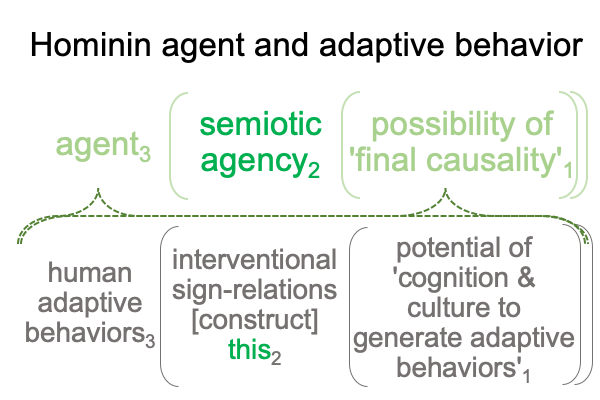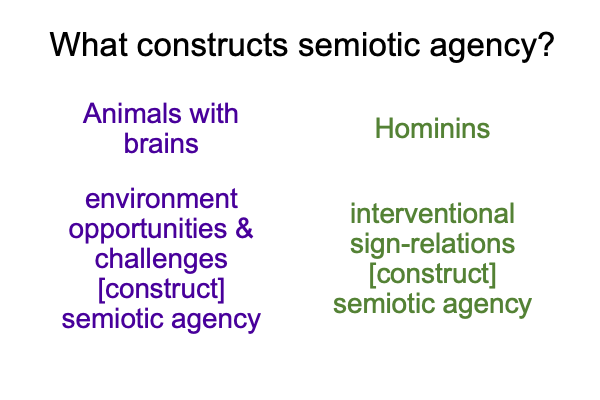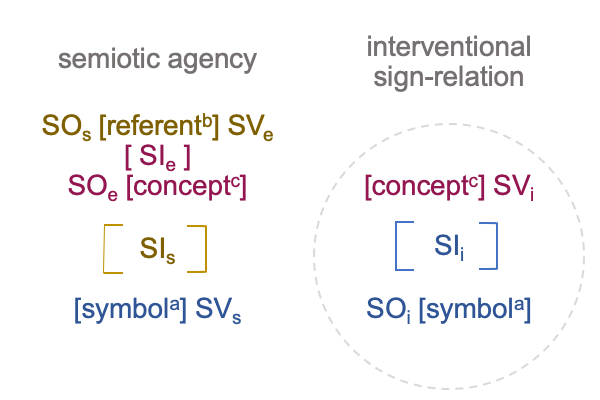1181 What about hominins?
Here is my picture of the same comparison for human ancestors.

1182 I see alterations in the second nested form.
1183 In the category of firstness, I see ‘cognition and culture’ instead of only ‘cognition’. What does this imply? The social circles that (as British anthropologist, Robin Dunbar, notes) seem to constellate in factors of three (family 5, intimate friends 5, team 15, band 50, community 150, mega-band 500, tribe 1500) are being selected for. Natural selection operates on both individuals and social circles.
1184 In the category of secondness, the convergent driver of hominin evolution includes interventional sign-relationsand the divergent driver is the same as for animal adaptive behaviors3.
From prior examinations, I know that the biosemiotic noumenal overlay, the thing that is common for all biological processes, consists of semiotic agency and the interventional sign-relation. If that is so, then interventional sign relations construct semiotic agency for the animals, too. Only, for animals, the construction is not as obvious as for humans.
1185 In the category of thirdness, the question arises, “Why is the normal context of human adaptive behaviors3 not the same as animal adaptive behaviors3?”
Hominins somehow take advantage of (not through cognition, per se, but through the evolution of human cognition) the opportunities (and dangers) afforded by the actuality of the interventional sign-relation as a purely relational structure.
Animals take advantage of interventional sign-relations as practical relational structures.
1186 Here is the comparison.

1187 Now, many theorists of evolution will substitute material-sounding terms for interventional sign-relations, such as “cooperation”, “culture”, “niche construction” and so on. But, these terms only show how crucial biosemiotics is for inquiry into mammalian (especially human) evolution.
1188 All biological process have the biosemiotic noumenal overlay in common.
Semiotic agency passes from a real initiating event2a (SVs) to information2b (SOs [referentb] SVe) to goal2c (SOe).
Then, there is a bridge to the interventional sign-relation within the goal2c, when action is taken as if the goal is attainable. The dyad for goal2c is {SOe [conceptc] SVi}2c.
1189 The SVi stands for the SOi in regards to the SIi.
When this nested form is reified (brought from thirdness into secondness), the SIi serves as the contiguity between two real elements, the SVi as matter and the SOi as form.
This is precisely the reification of the interventional sign-relation located in the biosemiotic noumenal overlay.

Note the dotted gray circle. That is the topic at hand.
I ask, “Does the interventional sign-relation “construct” semiotic agency?”
1190 The SIi stands at the heart of the interventional sign-relation. On the content-level, it sounds like this. The normal context of what is happening3a operates on the potential of ‘something’ happening’1a. Now, imagine [SIi] as a [substance] in the biosemiotic noumenal overlay.
For animals, the dyad is {address environmental (and ecological) opportunities and challenges2c (SVi) [what is happening3a: possibility of ‘something’ happening1a (SIi)] a sign-element that bridges to semiotic agency2a (SOi)}.
1191 So, does the environment or the ecology [construct] the semiotic agent?
Hmmm. How about an distraction?
There is still the conceptc, such as the contiguity between “spiders have venom and they bite” (the goal2c of avoiding bites, SOe) and an actual spider on one’s leg (the present danger, SVi, that will engage the agent’s attention). This version of Frege’s corner 2c bridges from semiotic agency to the interventional sign-relation.
Notice that the spider is an agent and so is the hominin.
1192 Once the conceptc is in play, another substance, [SIi] enters the picture and labels (more or less) what is happening3a in regards to the possibility of ‘something’ happening1a. Here, a spider on the thigh (SVi) stands for my intention to not let it bite me (or is it the spider’s intention to bite me?) (SOi) in regards to my intervention (as opposed to the spider’s) (SIi).
